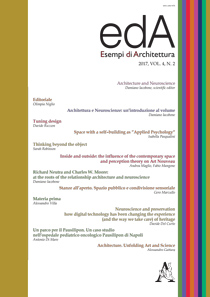Estratto da
ESEMPI DI ARCHITETTURA
International Journal of Architecture and Engineering
Materia Prima Materials
ESEMPI DI ARCHITETTURA
International Journal of Architecture and Engineering
Materia Prima Materials

Even if a positive valuation of natural materials do not meet at universal law of aesthetics, they are an evident trigger of peculiar sensorial-semantic feed-back and emotions that affect the material culture of humanity at a large extent. The unconditional love for natural looking surfaces is pushing a booming market of imitative materials, thanks to industrial technologies that mimic them precisely, instead of investing on innovative features. We can assume that brain is the fulcrum of this shared sentiment, as if some neuronal circuits were predisposed to ease certain aesthetic concepts. Recent neuroscience studies are exploring the hypothesis that some perceptive experiences may stimulate some kind of human brain pre-set organization. This essay suggests a scientific approach to investigate the universal appeal of natural surfaces in architecture, because built spaces meet a functional, perhaps “primitive”, need for shelter and protection, yet respond to a very sophisticated thinking. Architecture is a product of both biological and cultural evolution and like any other language or art is a spontaneous expression of human essence. Our commitment to design always new and better spaces comes from a biological pursue that meets different conditions, creating an infinite variety of solutions to improve life standards. Architecture is the replica of an endless play that takes place in our mental system and meets an indefinite number of different situations. Neuroscience latest studies suggest that the script of the play resides also in our biology
| pagine: | 63-70 |
| DOI: | 10.4399/97888255087279 |
| data pubblicazione: | Dicembre 2017 |
| editore: | Aracne |








